Qualcast Commodore rebuild
Hi everyone,
I have recently purchased this mower as a non-runner with the hopes of restoring it.
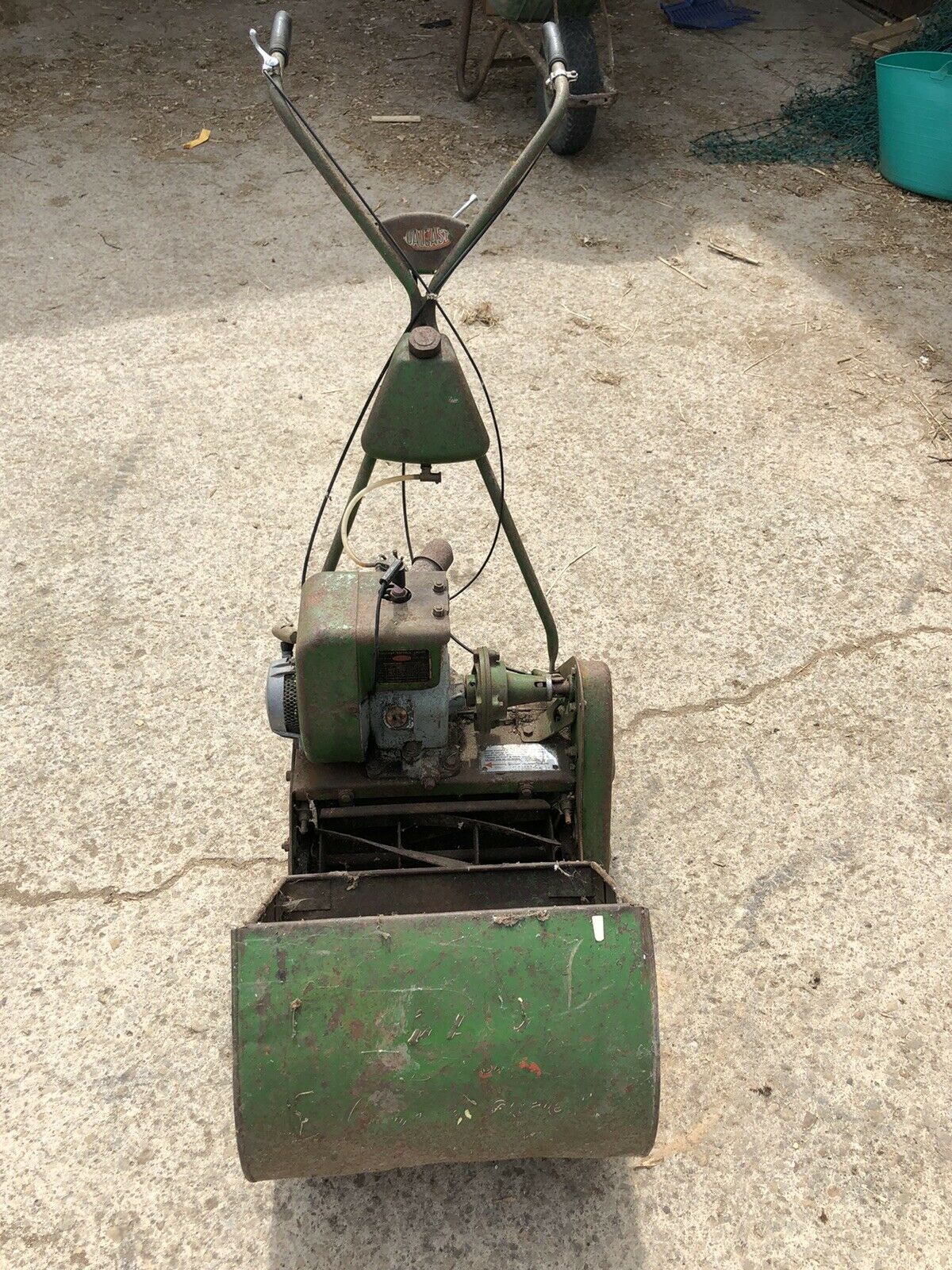
This is a brand new hobby for me, although I used to maintain my own motorbikes and cars back in the day when they were simpler to fix!
It has a Qualcast Suffolk engine, type 75G14, model 11A. Currently I am not getting a spark so I need to check out the magneto. My first question is how do you remove the flywheel to get at it? I thought that the Briggs and Stratton puller no. 19165 might do the job
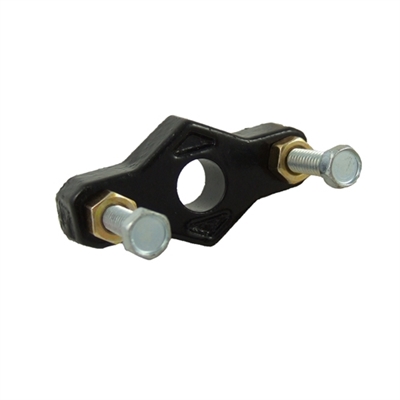
as its bolts have the correct spacing, but I have been advised by BriggBits that it probably wouldn't work. Here's a picture of the offending flywheel:
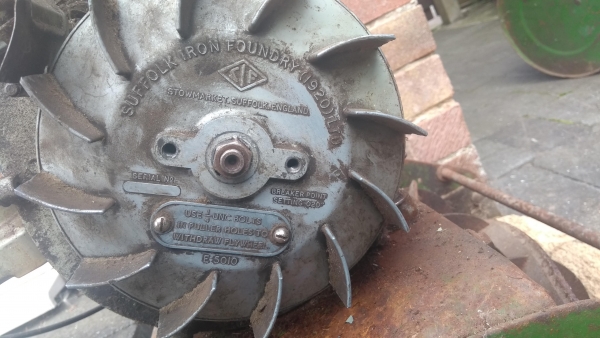
any help would be gratefully received.
Jon
Forums
Thanks for your advice
Thanks for your advice Wristpin. I cobbled together something using a bit of old bar and some bolts and it came off without drama:
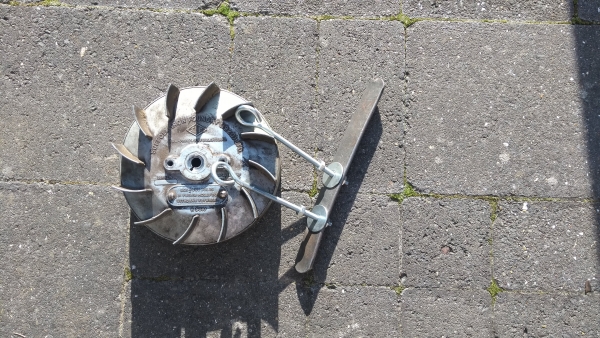
I then cleaned and re-gapped the points to 20 thou and tested the ignition coil for continuity. Got a resistance of 3900 ohms which I believe to be within acceptable limits. Also checked the HT lead and this was okay too. Re-assembled but still no spark. The points were quite pitted which leads me to suspect a duff condenser but not sure how I might check this. Can anyone recommend where I might get a new one from? The engine is a Suffolk 75G14 type 11A.
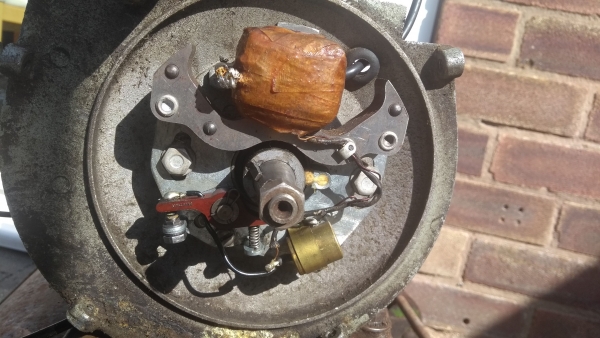
Thanks once again.
Jon Cruse at the Hailsham
Jon Cruse at the Hailsham Mower Centre is a good place to start looking for a condenser. Of late I’ve had difficulty in getting condensers of the exact size and bracket configuration but the condenser doesn’t have to be within the confines of the flywheel. If needs must it can be hung out side, the stud in the middle of the valve chest cover for instance.
Another option is to do away with both the points and the condense and fit an electronic trigger module such as the Meco or Nova. Once fitted there is rarely any further need to remove the flywheel again.
Just a thought re your lack of spark. Check that the points are really clean , pull a clean piece of paper through them. Also check that they are closing firmly , those centre pivot ones can bind on the pivot and hang .
Once again thanks for your
Once again thanks for your advice. I decided to replace the points and condenser with an electronic module. Here it is fitted within the magneto:
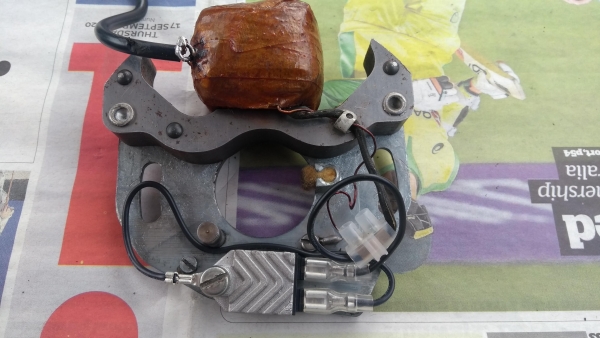
I have also ordered a replacement plug, plug cap and HT lead just for good measure. One thing that would be very helpful to know is the polarity of the earth on a Qualcast Commodore as it's fairly crucial to which way round I connect up the new trigger. I have assumed that a machine of this vintage would be positive earth and have wired it accordingly but it would be good to know for sure to avoid any further dismantling (in order to swap the connections round) if at all possible.
Also I have removed the engine from the chassis, lifted the head and removed the valves so that I can carry out a de-coke and grind the valves as I suspect poor compression. The piston crown looked nice and clean and the bore is in excellent condition with no detectable wear whatsoever.
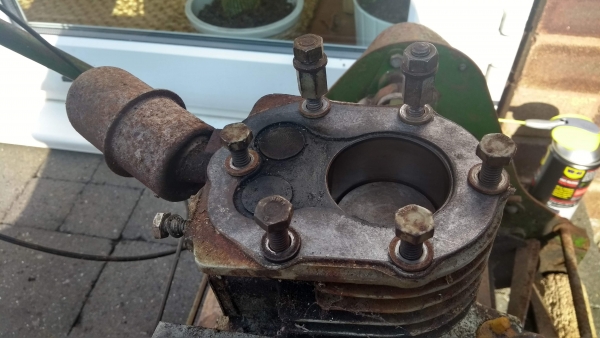
I don't suppose anyone would know where I might get my hands on a replacement silencer? The existing one looks very fragile...
Hopefully have it back together in a few days. I would like to get the engine running before I start on restoring the machine itself. Having great fun doing it, takes me back to my student motorcycling days, pure nostalgia!
I’m guessing, negative earth
I’m guessing, negative earth . That’s why I use the Meco unit rather than the Nova, as it’s smaller, single terminal and not polarity sensitive. However, if wired incorrectly, at the worst it won’t work and is unlikely to come to harm.
Silencer. I would think that you best chance is Jon Cruse at The Hailsham Mower Centre. Failing that , Briggs and Stratton do a small straight pipe “ cigar” one which may either be used straight or with a 30 degree malleable pipe bend.
Plug and cap. The best results are usually with an unsuppressed plug cap and a resistor plug . Not both suppressed !!
EDIT. Don’t forget to check / set the valve clearances.
Thanks once again for sharing
Thanks once again for sharing your knowledge.
I have lapped both valves in and am now getting a much better level of compression. If I need to increase the valve clearances I presume this is done by carefully grinding some metal off the end of the valve stems using a block of wood and an oilstone. Is that correct?
Also, regarding the silencer, you mention the Briggs and Stratton cigar type would something like this do?

I found it on eBay at:
Using it straight would cause it to foul the carburettor I think. Is it possible to bend it carefully at the point where I have arrowed, or would it be easier to fit the later box type silencer? I would like to keep it as original looking as possible so would prefer this shape if at all possible.
I think if you try to bend
I think if you try to bend that muffler, you will ruin it. You need to find a good plumbers merchant and obtain a 45 degree 1/2" BSP elbow and locknut.
I think if you try to bend
I think if you try to bend that muffler, you will ruin it. You need to find a good plumbers merchant and obtain a 45 degree 1/2" BSP elbow and locknut.
I second that - tried it a couple of years ago with the predicted result. I go with the male / female plumbing fitting .
https://www.pipedreamfittings.com/product-category/malleable-galvanised…
There are still a few of these around but you have to search them out - start with Jon Cruse
.
Valve clearances . EXH 15thou" Inlet 7
Yes, if too tight you will need to carefully remove metal from the end of the stem, maintaining a flat face at rightangles to the stem.
Valve through a block of wood
Valve through a block of wood works fine . If the silencer is still complete I would be tempted to leave alone . Trying to remove it will destroy the tin part and you may need oxy-acet to heat the stub red hot ( which is a taper bsp thread ) to part it from the block after 50+ years. Its easy to pass the point of no return.. .
With the big flywheel engine and the extra weight of the clutch these run really nicely, and have a good cut/yard rate to give a good finish to the lawn.
Note because ot the shallow sump they hold very little oil and tend to burn it so check regularly. If you swop the engine from a Suffolk or Atco you need to use the dipper on the big end from the Commodore as it is shorter
One thing I learnt about
One thing I learnt about Commodores many years ago was that the edge of the clutch cone tends to be very finger cutting sharp....ouch.!!
C.
Exhaust Valve After a…
Exhaust Valve
After a lengthy break I'm finally back on the restoration. I have removed the exhaust valve in order to grind some off the end of it to restore the correct clearance. Upon inspection, although I have managed to restore compression to the engine, it looks in a pretty sorry state:

Does anyone know where I might obtain a replacement? The engine is a Suffolk 75G14 type 11A if that's any help.
Any suggestions would be gratefully received.
Jon


You are on the right track.
You are on the right track. There is an eBay seller who offers various well made pullers at around £20 a throw but you can make one with a bit of bar and a couple of UNC hex head screws (threaded all the way up) and nuts. Actually I think that the Briggs one would work but you would need to put a bit of flat steel behind the centre hole to prevent damage to the crank or the nut.
Here is a more elaborate one that I made about 40 years ago and is still going strong. It has a centre forcing screw but its not necessary for your job.
However if you get a bit of steel just a bit longer that the bolt hole spacing in the flywheel, about an inch wide and with a minimum thickness of 5/16". Drill two holes the same distance apart as the holes in the flywheel. Undo the flywheel nut (LEFT HAND THREAD ) until it covers the end of the crank shaft; it is important to protect both the threaded end of the crank and its nut. Thread the nuts up the screws, pass them through your plate, position it over the nut and enter the screws into the threaded drillings in the flywheel. they need to be in about 3/8". Then evenly tighten the nuts down onto your plate and the flywheel should pop off . If it is reluctant to release give your plate a sharp tap with a hammer directly over the nut.